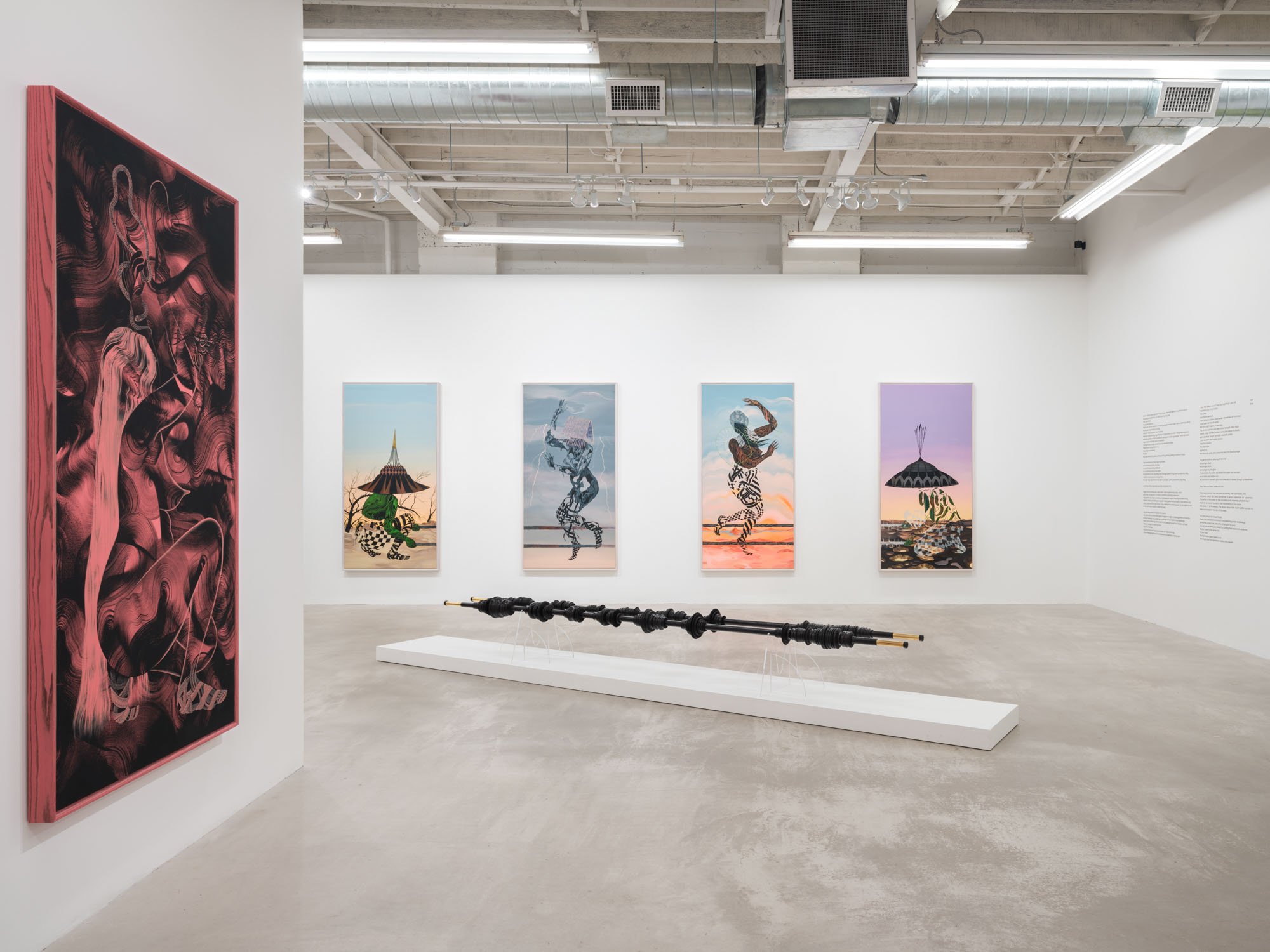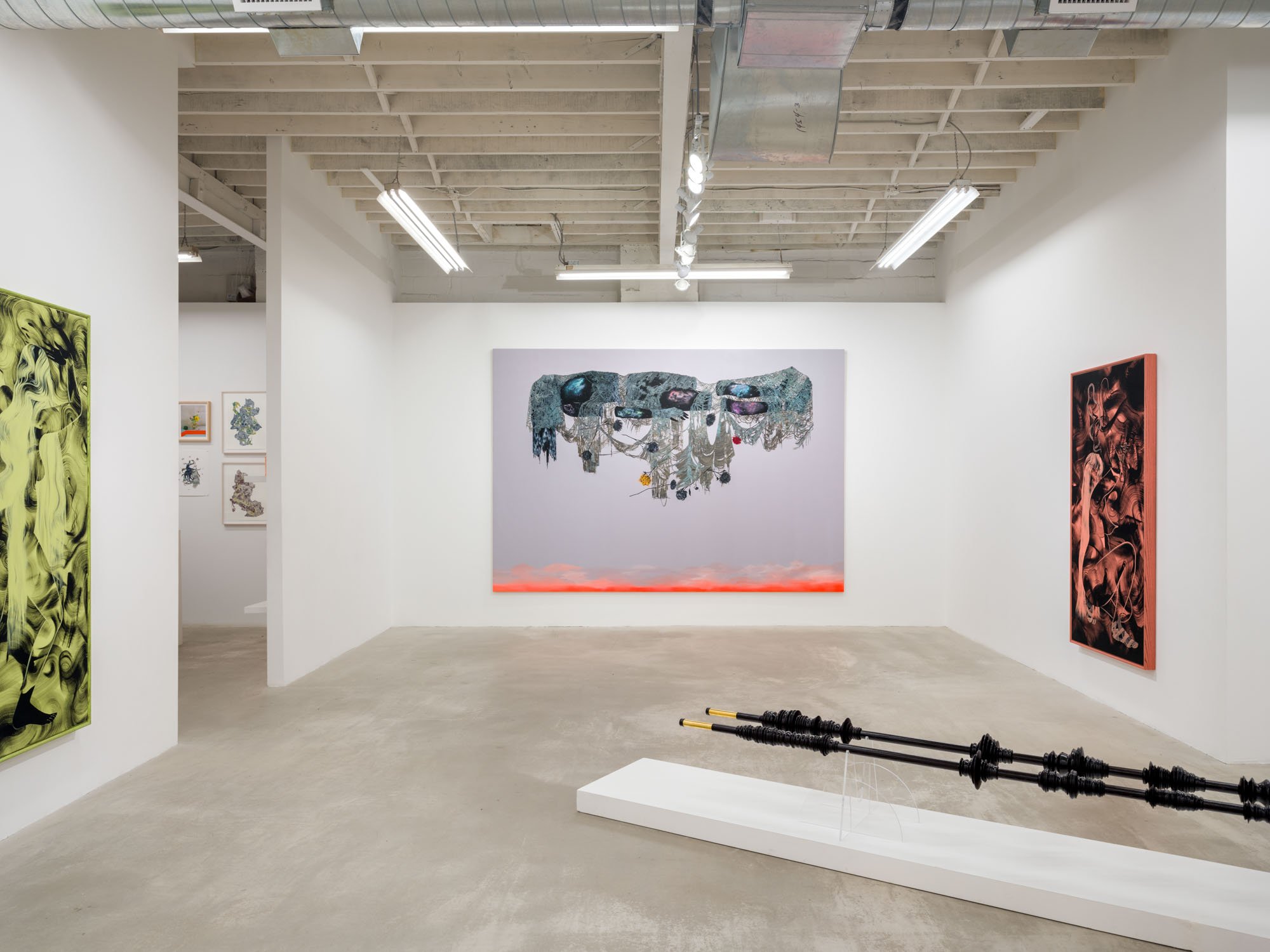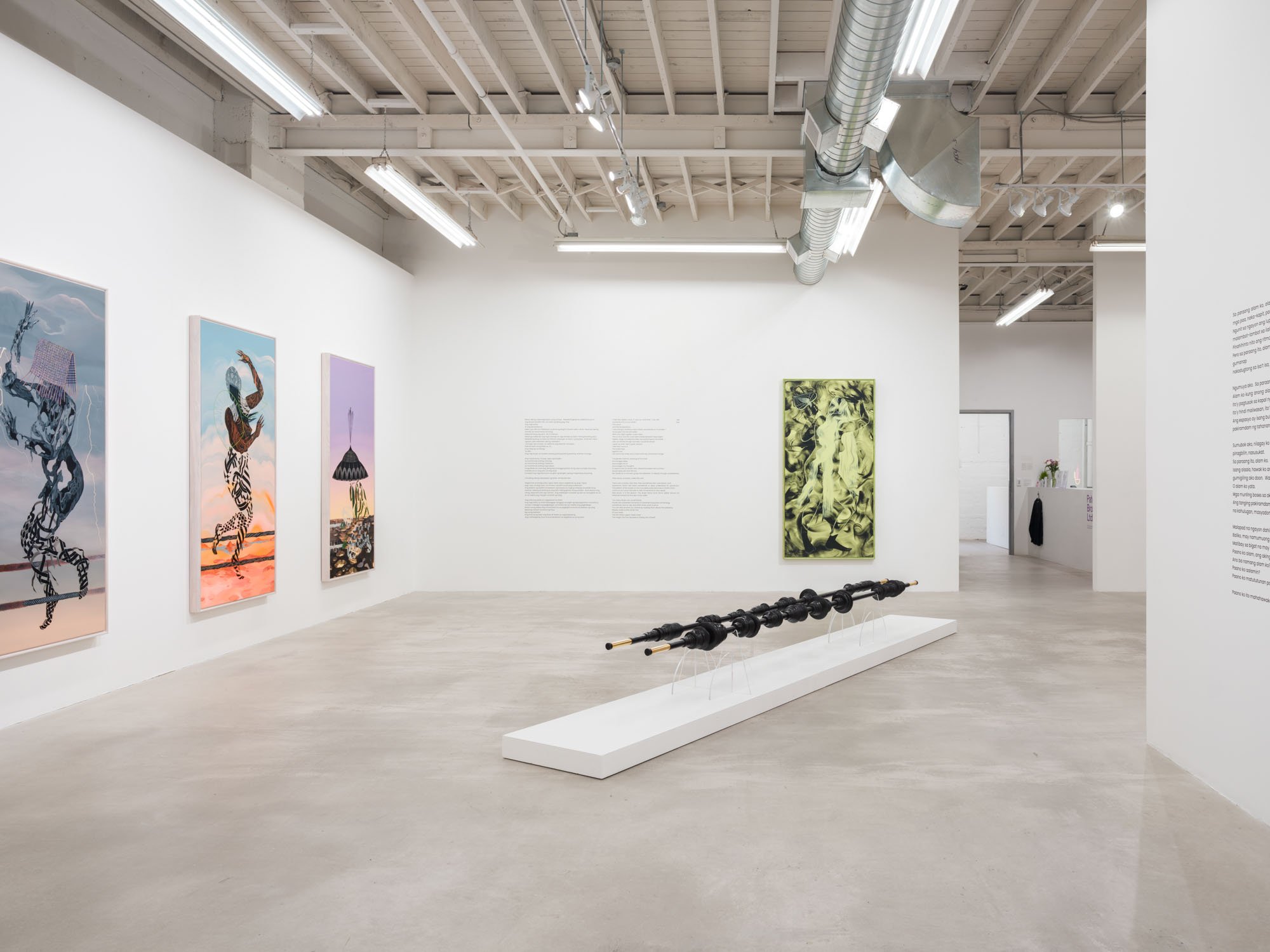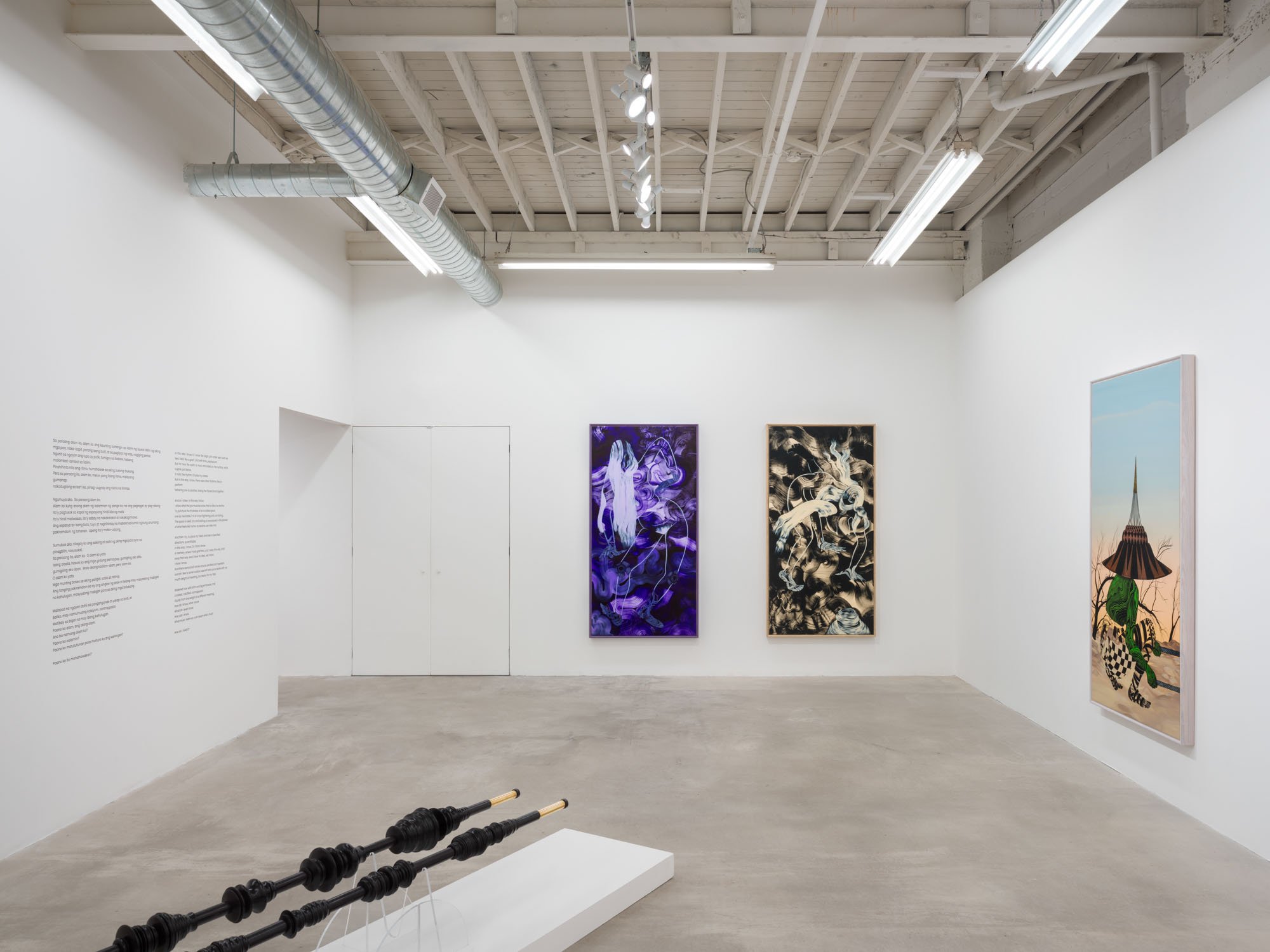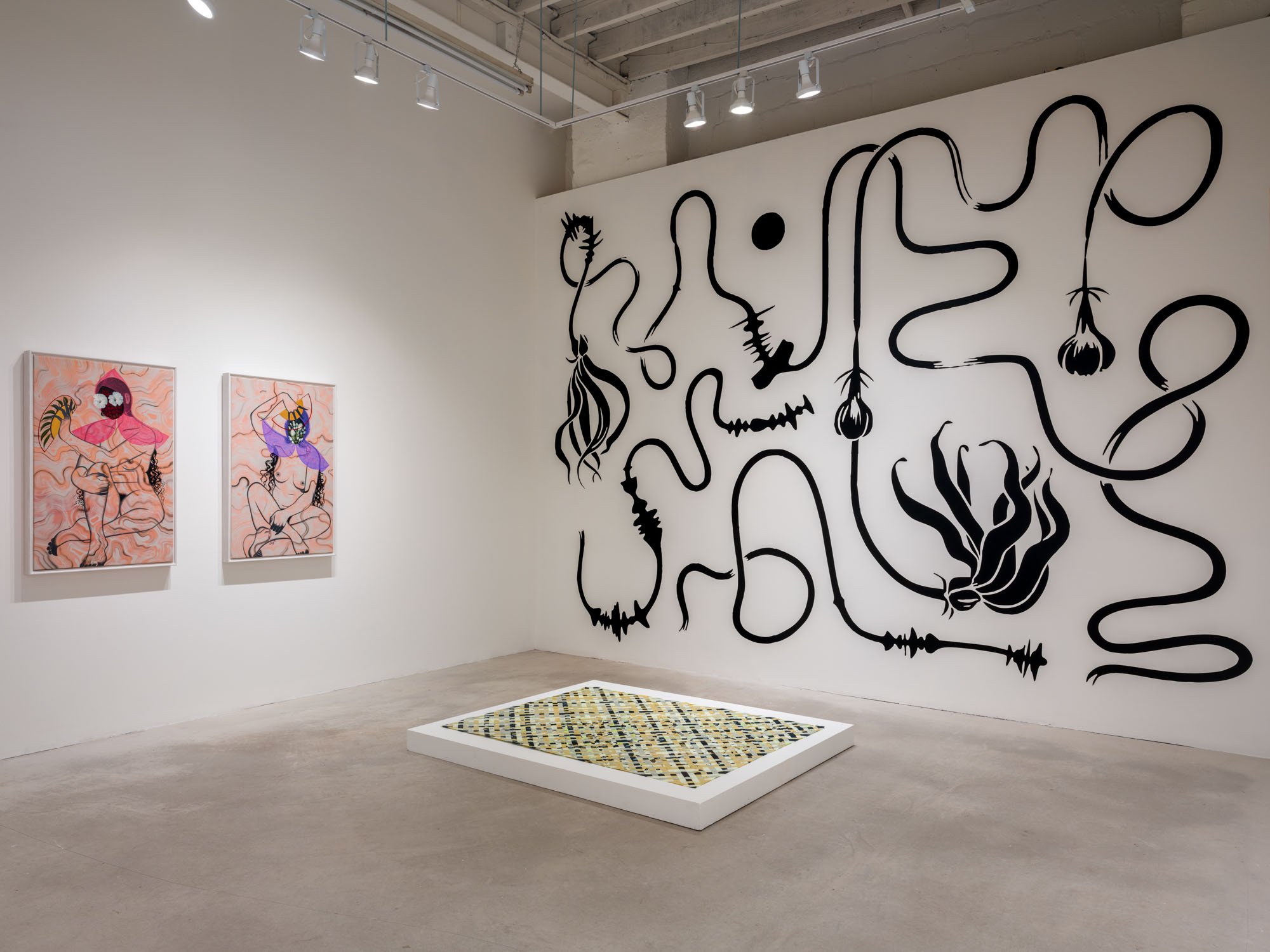21 WADE AVE #2 | TORONTO
Marigold Santos | the pace and rhythm of time, floating /
ang tulin at kumpas ng oras, lumulutang
22 JUNE - 29 july 2023
At The Edge of Not Yet and No Longer
When I was young, I would marvel at the low relief wood carvings of tinikling (1) dancers that hung on the wall in the basement of my east end suburban home in Toronto. Fashioned from narra, these figures affixed in suspense, mid-air, in graceful gestures said to mimic the tikling bird, who waded through the rice paddies of the rural Philippines while evading farmers’ traps.
the pace and rhythm of time, floating / ang tulin at kumpas ng oras, lumulutang is the title of Marigold Santos’ exhibition at the South Alberta Art Gallery Maansiksikaitsitapiitsinikssin. The allusions to dance, particularly the tinikling, are iconic and clear, yet, the artist draws on much more than that. Santos crafts a multisensory aesthetic experience in the gallery—poetic ruminations on mothering, fragments of childhood memories, sonic atmospheres, and otherworldly abstractions that evoke her profuse diasporic consciousness.
Santos recognizes her immigration from the Philippines as the departure point for her work. The artist reconfigures Philippine materiality, traditional sartorial elements, flora, and most stunningly, the formidable figure of the asuang (aswang), the medicine woman (2) of pre-colonial Philippine society, who was demonized by the Spanish missionizing project in order to subdue her power. Along with her expansive repertoire of visual vocabularies, Santos mobilizes this extraordinary being to speak of the multiplicity and complexity of the diasporic condition.
=====
Central to this exhibition are two series of four paintings that mirror each other, yet contain asymmetries and new directions in abstraction that point to the artists’ transformation as a new mother.
The first series, shroud tinikling, is ripe with iconographic abundance: it contains sumptuous details, the visualizations of sensorial memories, tempestuous milieux, and supernatural dancers.
The first two figures wear the narra grain on their bodies, reminiscent of the relief sculpture that also hung in Santos’ ancestral home. In the second painting, the figure dons the translucent butterfly sleeves of a terno. Their pleated architecture is ghostly indicated by geometric lines radiating from the shoulder. Mina Roces illuminates the complexity of the terno in 20th century Philippine politics. Popularized by the infamous Imelda Marcos, the terno signified nationalism and a form of gendered dress that indexed the role of the woman as the emissary of tradition.(3) However, Santos disrupts this essentialist and nationalist logic through visual strategies of haunting: translucency, the unraveling of weave, and the dissolution of flesh all evince the porous and amorphic realities of diasporic identity formation as a spectral practice unbounded by borders or social order. The Spanish intended the pañuelo–the forebearer of the butterfly sleeve–to conceal the breast of Indigenous Filipinos. Yet in Santos’ rendering, the dancing asuangs revel–naked, free, and transcendent.
Since becoming a mother, Santos contemplates the responsibility of cultivating cultural values within her child. Santos’ dancers suggest that this work is as much an embodied and creative practice, as it is an inherited one. The dancers, like the tikling birds, float in the in-between, eluding the trappings of fixity. This in-betweenness is the dance of diaspora, the sometimes choreographed and sometimes improvised movements that allow us to navigate pain, joy, and all the affects in between the edge of not yet and no longer.
=====
The article, Mothers as Makers of Death by Claudia Dey, states: “when a woman becomes a mother, a set of changes is set off within her; the most altering is that she, as if under a spell, loses her mind.”(4) A mother is a heavy multitasker. She possesses a fragmented mind from having multitudes etched upon it—the wellbeing of her child, her loved ones, her career, her myriad origins, and more.
Santos approximates this sensation through the second series of four paintings called shroud envisioning. Each depicts one of four faceless figures clouded by plumes of miasma made from large undulating brushstrokes spilling in and out of the hollow bodies. Outlined by strokes of white-tinted paint, their forms resemble a banshee-like creature haunting Filipino folklore called the white lady.(5) Like many mother figures, this ghost wanders aimlessly from dusk until dawn, only finding rest by momentarily pausing to haunt the living. The artist relies on the supernatural to allude towards invisibilized forms of labor that stays concealed in the domestic sphere.
In Santos’ work, the items tethering her spectres in the void-like space are hands and feet or even ancestral items made from woven structures rendered in paint. The interlocking woven patterns are common features in her art as signifiers of her diasporic experience. Through the artist’s strategic placement in the second series, they take on alternative meanings. It points to the tools of care used during acts of mothering but also gestures towards tension from exhaustion. Despite the existence of this tension, the artist, through her new series, finds that motherwork together with elements from her practice, grounds her floating spirit.
=====
Hauntology (6) is a concept that refers to phenomena of social/cultural elements of the past persistently appearing in the present. Fragmented abstractions of public figures, events, and more are evoked into the present as spectres that take on alternative meanings, indicating the death of the original author(s). (7)
Santos’ style of figuration reflects this quality by abstracting Filipinx cultural elements then further abstracting them into their simplest forms. Doing so, the artist breathes new ways of meaning-making to intersect with them while alluding to her framework. Her fragmented figures are neither here nor there, they exist on open-ended liminal landscapes void of time and space. By avoiding traditional forms of representation, the artist highlights capacious spectral presences through the aesthetic of absence. This strategy allows her spirits to escape the panopticon of dominant epistemology. Shroud tinikling occupies the gallery’s south walls, while the other series, shroud envisioning, are placed on both adjacent ends. Parallel to these 8 paintings are poetic ruminations, oscillating between English and Tagalog, mirroring the themes of the two series. This creates a reflective space that prompts viewers to consider hidden undisclosed secrets, spectral presence or meaning makings that are often negated when a narrative is presented.
Her works resemble a procession for many kinds of departures and ends entangled with inhabiting multiple worlds vis à vis being a new mother. Each of Santos’ two series is similar to the entrance of the four horsemen of the apocalypse, harbingers of the end from the book of revelations, mirroring each other. Instead of cataclysm alone, Santos’ apparitions channel contrasting reflections||refractions on the paradox of the diasporic experience and motherwork.
— Excel Garay & Marissa Largo
1. The tinikling is a Philippine folkloric dance that consists of dancers who step in and out of clapping bamboo poles.
2. In pre-colonial Philippine society, the babaylan was the shaman who had knowledge of medicine, midwifery, and ritual.
3. Mina Roces, “Gender, Nation and the Politics of Dress in Twentieth-Century Philippines,” Gender & History 17, no. 2 (2005): 355.
4. Claudia Dey, Mothers as Makers of Death, The Paris Review, 2018.
5. In Filipino folklore, the white lady is an apparition that was born from great tragedy or loss.
6. A portmanteau term that combines haunting and ontology, first coined by Jacques Derrida from The Spectres of Marx (1993).
7. Jacques Derrida, The Spectres of Marx, Routledge, 2012, p. 10.
Marigold Santos pursues an inter-disciplinary art practice involving drawn, painted, and printed works, sculpture, tattooing, and sound. Her work explores self-hood and identity that embraces multiplicity, fragmentation and
empowerment, as informed by diasporic experiences. She holds a BFA from the University of Calgary, and an MFA from Concordia University. As a recipient of grants from the Canada Council for the Arts, the Alberta Foundation for the Arts, and the Conseil des Arts et des Lettres du Québec, she continues to exhibit widely across Canada. Her recent solo exhibitions include the pace and rhythm of time, floating at the Southern Alberta Art Gallery (2023), binhi at buhol at Jarvis Hall Gallery (2021), hiwa-hiwalay at Patel Brown in Toronto (2020), SURFACE TETHER at the Art Gallery of Alberta (2019), MALAGINTO at the Montreal Arts Interculturels, and the Dunlop Art Gallery in Regina (2019). She was selected to be a collaborating artist with Yoko Ono’s Water Event piece in the exhibition Growing Freedom (2019) and exhibited her works in Relations – Diaspora and Painting (2020), both at the Fondation Phi in Montreal, with Relations – Diaspora and Painting exhibiting at the Esker Foundation in 2021. Marigold Santos lives and works on Treaty 7 Territory, in Mohkinstsis/Calgary.
Excel Garay is an artist-curator and community worker operating on Mi’kma’ki in Kjipuktuk/Halifax, Nova Scotia. Her work, in these intersecting roles, is informed by mutual desires discovered through acts of collaboration and her lived experience. She graduated with distinction from NSCAD University with a double degree in Bachelor of Arts in Art History and Bachelor of Fine Arts in Fine Arts (2022). Garay’s artistic and academic lens are informed by Hauntology, coined by Jacques Derrida in his book Spectres of Marx, which allows her to better
commune with postcolonial cultural productions, anti-colonial aesthetics, residual memories, and spectrality.
Dr. Marissa Largo is an Assistant Professor of Creative Technologies in the School of Arts, Media, Performance & Design of York University. Her research, research-creation, and curatorial work focuses on the intersections of community engagement, race, gender, and Asian diasporic cultural production. Her
forthcoming book, Unsettling Imaginaries: Filipinx Contemporary Artists in Canada (University of Washington Press) examines the work and oral histories of artists (including Marigold Santos) who imagine Filipinx subjectivity beyond
colonial logics. Her 2021 curatorial project Elusive Desires: Ness Lee & Florence Yee at the Varley Art Gallery of Markham earned two Galeries Ontario/Ontario Galleries (GOG) awards for best exhibition design and installation and best curatorial writing text between 2000 – 5000 words). Dr. Largo is co-editor of Diasporic Intimacies: Queer Filipinos and Canadian Imaginaries (Northwestern University Press, 2017) and has served as the Canada Area Editor of the Journal of Asian Diasporic Visual Cultures and the Americas (ADVA) since 2018.

